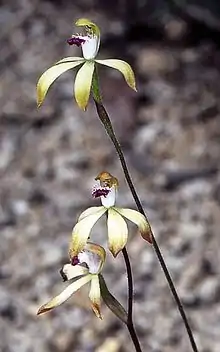| Golden caps | |
|---|---|
 | |
| Caladenia hildae growing in the Monaro | |
| Scientific classification | |
| Kingdom: | Plantae |
| Clade: | Tracheophytes |
| Clade: | Angiosperms |
| Clade: | Monocots |
| Order: | Asparagales |
| Family: | Orchidaceae |
| Subfamily: | Orchidoideae |
| Tribe: | Diurideae |
| Genus: | Caladenia |
| Species: | C. hildae |
| Binomial name | |
| Caladenia hildae | |
| Synonyms[1] | |
Caladenia hildae, commonly known as golden caps,[2] honey caladenia[3] or honey hood[4] is a plant in the orchid family Orchidaceae and is endemic to the south-east of mainland Australia. It is a ground orchid with a single leaf and up to four yellowish-brown to golden-brown flowers with darker tips on the sepals and petals.
Description
Caladenia hildae is a terrestrial, perennial, deciduous, herb with an underground tuber and a single, sparsely hairy, linear leaf, 70–200 mm (3–8 in) long and 1–3 mm (0.04–0.1 in) wide. There are up to four flowers on a spike 80–200 mm (3–8 in) tall. The flowers are yellowish-brown to golden-brown flowers with darker tips. The sepals and petals have pointed, drooping tips. The dorsal sepal is erect, 9–11 mm (0.35–0.43 in) long and about 3 mm (0.1 in) wide and curves forward forming a hood over and around the sides of the column. The lateral sepals and petals are 11–14 mm (0.4–0.6 in) long and about 3 mm (0.1 in) wide. The labellum is egg-shaped, 6–9 mm (0.2–0.4 in) long, 4–6 mm (0.16–0.24 in) wide with the sides turned up and the tip rolled under. The labellum is white with a dark purple, glandular tip, narrow white or yellow-tipped teeth on the sides and four crowded rows of calli along its mid-line. Flowering occurs in October and November.[3][2][5]
Taxonomy and naming
Caladenia hildae was first formally described in 1928 by Edward Pescott and William Nicholls and the description was published in The Victorian Naturalist.[1][6] The specific epithet (hildae) honours Hilda Elliott for her assistance in obtaining grant money.[6] Although recognised by the Royal Botanic Gardens, Melbourne and the National Herbarium at the Royal Botanic Gardens, Sydney as a valid name, C. hildae is regarded as a synonym of Caladenia testacea var. hildae by the Royal Botanic Gardens, Kew.[7]
Distribution and habitat
Golden caps grows in sparse or heathy forest and woodland in high-altitude areas in New South Wales south from the Kybean Range and in Victoria mainly eastwards from Omeo.[3][2][5]
Conservation
Caladenia hildae is listed as "rare" by the Victorian Government Department of Sustainability and Environment.[4]
References
- 1 2 3 "Caladenia hildae". APNI. Retrieved 10 February 2017.
- 1 2 3 Jones, David L. (2006). A complete guide to native orchids of Australia including the island territories. Frenchs Forest, N.S.W.: New Holland. p. 47. ISBN 1877069124.
- 1 2 3 Jeanes, Jeffrey. "Caladenia hildae". Royal Botanic Gardens Victoria: Vicflora. Retrieved 10 February 2017.
- 1 2 "Advisory list of rare or threatened plants - 2014" (PDF). Government of Victoria, Department of Sustainability and Environment. Retrieved 29 June 2017.
- 1 2 Bernhardt, Peter. "Caladenia hildae". Royal Botanic Gardens Sydney: plantnet. Retrieved 10 February 2017.
- 1 2 Pescott, Edward Edgar; Nicholls, William Henry (1929). "A new species of orchid". The Victorian Naturalist. 45 (9): 235–237. Retrieved 29 June 2017.
- ↑ "Caladenia hildae". World Checklist of Selected Plant Families (WCSP). Royal Botanic Gardens, Kew.